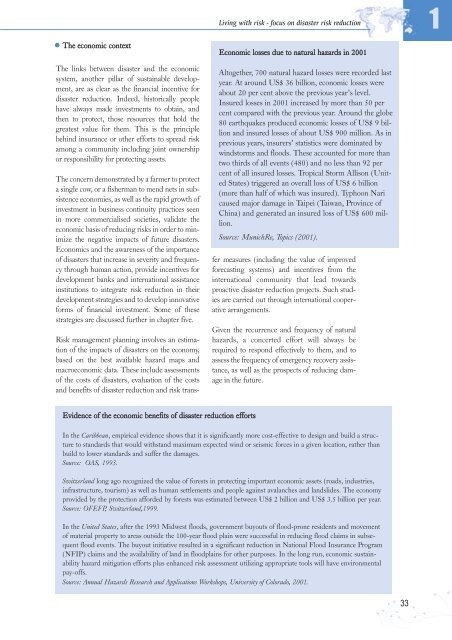A global review of disaster reduction initiatives - Welcome to the ...
A global review of disaster reduction initiatives - Welcome to the ...
A global review of disaster reduction initiatives - Welcome to the ...
You also want an ePaper? Increase the reach of your titles
YUMPU automatically turns print PDFs into web optimized ePapers that Google loves.
Living with risk - focus on <strong>disaster</strong> risk <strong>reduction</strong>1The economic contextThe links between <strong>disaster</strong> and <strong>the</strong> economicsystem, ano<strong>the</strong>r pillar <strong>of</strong> sustainable development,are as clear as <strong>the</strong> financial incentive for<strong>disaster</strong> <strong>reduction</strong>. Indeed, his<strong>to</strong>rically peoplehave always made investments <strong>to</strong> obtain, and<strong>the</strong>n <strong>to</strong> protect, those resources that hold <strong>the</strong>greatest value for <strong>the</strong>m. This is <strong>the</strong> principlebehind insurance or o<strong>the</strong>r efforts <strong>to</strong> spread riskamong a community including joint ownershipor responsibility for protecting assets.The concern demonstrated by a farmer <strong>to</strong> protecta single cow, or a fisherman <strong>to</strong> mend nets in subsistenceeconomies, as well as <strong>the</strong> rapid growth <strong>of</strong>investment in business continuity practices seenin more commercialised societies, validate <strong>the</strong>economic basis <strong>of</strong> reducing risks in order <strong>to</strong> minimize<strong>the</strong> negative impacts <strong>of</strong> future <strong>disaster</strong>s.Economics and <strong>the</strong> awareness <strong>of</strong> <strong>the</strong> importance<strong>of</strong> <strong>disaster</strong>s that increase in severity and frequencythrough human action, provide incentives fordevelopment banks and international assistanceinstitutions <strong>to</strong> integrate risk <strong>reduction</strong> in <strong>the</strong>irdevelopment strategies and <strong>to</strong> develop innovativeforms <strong>of</strong> financial investment. Some <strong>of</strong> <strong>the</strong>sestrategies are discussed fur<strong>the</strong>r in chapter five.Risk management planning involves an estimation<strong>of</strong> <strong>the</strong> impacts <strong>of</strong> <strong>disaster</strong>s on <strong>the</strong> economy,based on <strong>the</strong> best available hazard maps andmacroeconomic data. These include assessments<strong>of</strong> <strong>the</strong> costs <strong>of</strong> <strong>disaster</strong>s, evaluation <strong>of</strong> <strong>the</strong> costsand benefits <strong>of</strong> <strong>disaster</strong> <strong>reduction</strong> and risk trans-Economic losses due <strong>to</strong> natural hazards in 2001Al<strong>to</strong>ge<strong>the</strong>r, 700 natural hazard losses were recorded lastyear. At around US$ 36 billion, economic losses wereabout 20 per cent above <strong>the</strong> previous year’s level.Insured losses in 2001 increased by more than 50 percent compared with <strong>the</strong> previous year. Around <strong>the</strong> globe80 earthquakes produced economic losses <strong>of</strong> US$ 9 billionand insured losses <strong>of</strong> about US$ 900 million. As inprevious years, insurers’ statistics were dominated bywinds<strong>to</strong>rms and floods. These accounted for more thantwo thirds <strong>of</strong> all events (480) and no less than 92 percent <strong>of</strong> all insured losses. Tropical S<strong>to</strong>rm Allison (UnitedStates) triggered an overall loss <strong>of</strong> US$ 6 billion(more than half <strong>of</strong> which was insured). Typhoon Naricaused major damage in Taipei (Taiwan, Province <strong>of</strong>China) and generated an insured loss <strong>of</strong> US$ 600 million.Source: MunichRe, Topics (2001).fer measures (including <strong>the</strong> value <strong>of</strong> improvedforecasting systems) and incentives from <strong>the</strong>international community that lead <strong>to</strong>wardsproactive <strong>disaster</strong> <strong>reduction</strong> projects. Such studiesare carried out through international cooperativearrangements.Given <strong>the</strong> recurrence and frequency <strong>of</strong> naturalhazards, a concerted effort will always berequired <strong>to</strong> respond effectively <strong>to</strong> <strong>the</strong>m, and <strong>to</strong>assess <strong>the</strong> frequency <strong>of</strong> emergency recovery assistance,as well as <strong>the</strong> prospects <strong>of</strong> reducing damagein <strong>the</strong> future.Evidence <strong>of</strong> <strong>the</strong> economic benefits <strong>of</strong> <strong>disaster</strong> <strong>reduction</strong> effortsIn <strong>the</strong> Caribbean, empirical evidence shows that it is significantly more cost-effective <strong>to</strong> design and build a structure<strong>to</strong> standards that would withstand maximum expected wind or seismic forces in a given location, ra<strong>the</strong>r thanbuild <strong>to</strong> lower standards and suffer <strong>the</strong> damages.Source: OAS, 1993.Switzerland long ago recognized <strong>the</strong> value <strong>of</strong> forests in protecting important economic assets (roads, industries,infrastructure, <strong>to</strong>urism) as well as human settlements and people against avalanches and landslides. The economyprovided by <strong>the</strong> protection afforded by forests was estimated between US$ 2 billion and US$ 3.5 billion per year.Source: OFEFP, Switzerland,1999.In <strong>the</strong> United States, after <strong>the</strong> 1993 Midwest floods, government buyouts <strong>of</strong> flood-prone residents and movement<strong>of</strong> material property <strong>to</strong> areas outside <strong>the</strong> 100-year flood plain were successful in reducing flood claims in subsequentflood events. The buyout initiative resulted in a significant <strong>reduction</strong> in National Flood Insurance Program(NFIP) claims and <strong>the</strong> availability <strong>of</strong> land in floodplains for o<strong>the</strong>r purposes. In <strong>the</strong> long run, economic sustainabilityhazard mitigation efforts plus enhanced risk assessment utilizing appropriate <strong>to</strong>ols will have environmentalpay-<strong>of</strong>fs.Source: Annual Hazards Research and Applications Workshops, University <strong>of</strong> Colorado, 2001.33

















